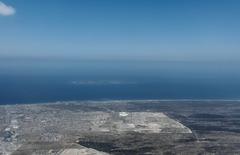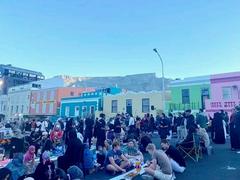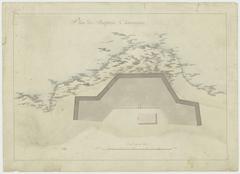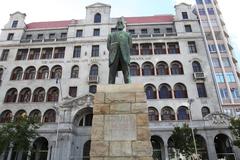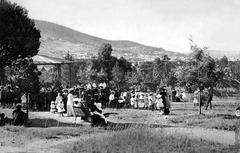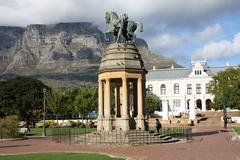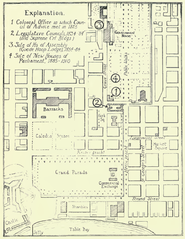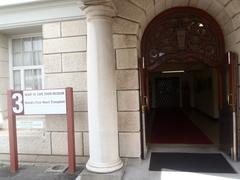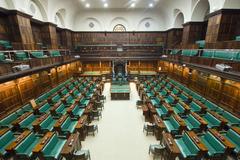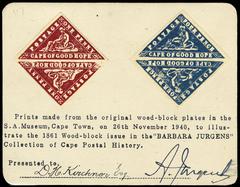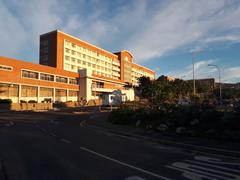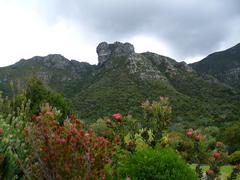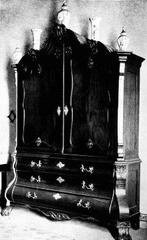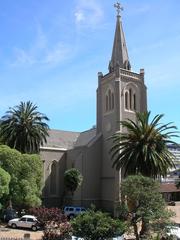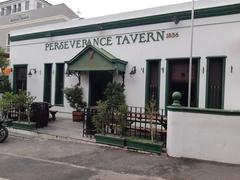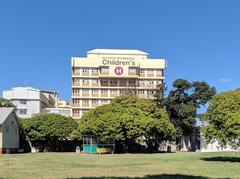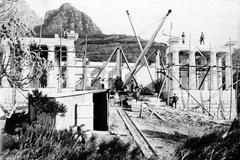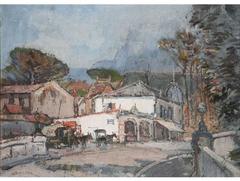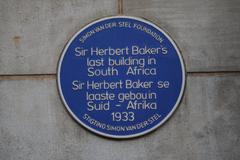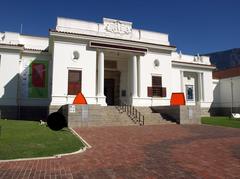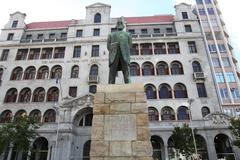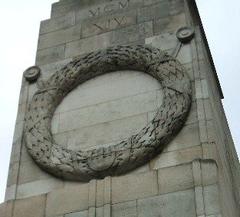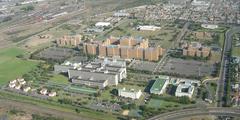Queen’s Blockhouse Cape Town: Visiting Hours, Tickets, and Historical Sites Guide
Date: 14/06/2025
Introduction
Perched on the eastern slopes of Devil’s Peak and framed by the majestic Table Mountain, Queen’s Blockhouse is a fascinating relic from Cape Town’s colonial past. Built during the First British Occupation of the Cape in the late 18th century, this sturdy stone structure once played a key role in the defense of Cape Town and its strategic harbor. Today, the blockhouse is not only a testament to military engineering but also a sought-after destination for history buffs, hikers, and anyone drawn to the city’s layered heritage and breathtaking mountain vistas (Artefacts; South African History Online).
This detailed guide explores the blockhouse’s history, architectural features, and cultural significance. It also offers practical advice for visitors—covering opening hours, ticketing, directions, accessibility, safety, and nearby attractions—so you can maximize your experience at one of Cape Town’s most atmospheric historical sites. For the latest updates and enhanced travel resources, consider downloading the Audiala app, a companion for heritage tourism in Cape Town.
Table of Contents
- Historical Background of Queen’s Blockhouse
- Architectural Features and Military Engineering
- Historical Role and Military Strategies
- Decline and Preservation
- Cultural and Heritage Significance
- Recognition and Heritage Status
- Visiting Information
- Best Time to Visit
- Nearby Attractions
- Guided Tours and Interpretation
- Photography and Visual Highlights
- Frequently Asked Questions (FAQ)
- Conclusion
- Sources and Further Reading
Historical Background of Queen’s Blockhouse
Queen’s Blockhouse was constructed in 1796 by the British Royal Engineers, following their takeover of the Cape from the Dutch. It formed part of a defensive chain on Devil’s Peak, including the King’s Blockhouse and Prince of Wales Blockhouse, designed to protect the vital port city from landward threats and serve as an early warning system (The Heritage Portal; Wikipedia: Table Mountain).
Named in honor of Queen Charlotte, wife of King George III, the blockhouse commanded sweeping views of Table Bay and the approaches to Cape Town, making it a crucial outpost for monitoring enemy movements and signaling between fortifications.
Architectural Features and Military Engineering
Built from locally quarried stone, Queen’s Blockhouse was designed for durability and defense. Typical features included:
- Thick, squared stone walls to withstand artillery and musket fire
- Musket loopholes and embrasures for small cannon or swivel guns
- Multiple storeys to house a garrison and store ammunition
- Flat roof and parapets for additional protection and observation
The blockhouse’s elevated position maximized its defensive capabilities and allowed for communication with other fortifications and the Castle of Good Hope (Artefacts).
Historical Role and Military Strategies
During the Napoleonic Wars and ongoing European rivalries, the British fortified the Cape Peninsula to counter possible invasions and control local unrest. Queen’s Blockhouse served as both a stronghold and a signal post, linking a network of defenses that marked the boundary between Cape Town and outlying rural areas (The Heritage Portal).
While its strategic importance waned with advances in military technology, the blockhouse remained a symbol of British power and a deterrent to both foreign and internal threats (Wikipedia: Table Mountain).
Decline and Preservation
The Queen’s Blockhouse, like its counterparts, eventually fell into disuse as military needs evolved and urban development expanded. Today, it survives as a ruin, with sections of its original structure still visible, offering a tangible link to Cape Town’s turbulent past (Artefacts).
Although it has not been formally declared a national monument, it is included in local heritage inventories and attracts historians, hikers, and heritage enthusiasts alike.
Cultural and Heritage Significance
The blockhouse stands on land once inhabited by the !Uriǁʼaekua (Goringhaiqua) and Khoekhoen, who referred to Table Mountain as Huriǂ’oaxa, or “ocean-emerging (mountain).” Its history thus reflects the intersection of local indigenous culture and European colonial ambitions (Wikipedia: Table Mountain).
Queen’s Blockhouse predates the widespread blockhouse constructions of the Anglo-Boer War, making it unique in both design and context (The Heritage Portal: Blockhouses of the South African War). It continues to serve as an educational resource and a focal point for heritage tourism in Cape Town (South Africa.net).
Recognition and Heritage Status
While the King’s Blockhouse was declared a National Monument in 1938, Queen’s Blockhouse does not currently enjoy the same formal protection. Nonetheless, it is recognized for its historical value and is included in heritage inventories and tourism initiatives (The Heritage Portal).
Visiting Information
Visiting Hours and Tickets
Queen’s Blockhouse is an open-access site within Table Mountain National Park:
- Hours: Sunrise to sunset, year-round (Evendo)
- Tickets: No separate fee; access is free as part of the park. Table Mountain National Park does not require a ticket for hiking to the blockhouse.
Directions and Access
- Trailhead: Most visitors start at Rhodes Memorial, which offers parking, restrooms, and a café.
- Hiking Route: The walk from Rhodes Memorial is about 1.5 km (30–45 minutes), moderately steep with well-marked paths.
- Alternative Access: From the end of Tafelberg Road or via the MyCiTi bus to the Table Mountain Aerial Cableway station, followed by a scenic hike (Mapcarta; Evendo).
Accessibility
Due to uneven, rocky terrain and steep gradients, the blockhouse is not wheelchair accessible. The hike is suitable for moderately fit visitors; sturdy shoes are essential.
Safety Tips
- Hike in groups, especially during quiet times (Charlie on Travel).
- Stay on marked trails.
- Avoid carrying valuables, and keep belongings secure.
- Let someone know your hiking plans.
- Bring sufficient water, sun protection, and rain gear.
- Return before sunset; the area is not lit at night.
- Emergency contact: 10111; consider the Namola Safety App (Cape Town Travel).
What to Bring
- Comfortable walking shoes
- Hat, sunscreen, and sunglasses
- Layered clothing (weather changes quickly)
- 1–2 liters of water per person
- Snacks
- Camera
- Map or GPS-enabled device with offline maps
Facilities
There are no facilities at Queen’s Blockhouse itself. Amenities (including restrooms and a restaurant) are available at Rhodes Memorial. Overnight stays are not permitted.
Best Time to Visit
- Spring (September–November): Pleasant temperatures, fewer crowds, and clear views.
- Autumn (March–May): Mild weather, optimal hiking conditions.
- Summer (December–February): Hot and busy; visit early morning or late afternoon.
- Winter (June–August): Cooler and wetter; trails may be slippery (Travellers Worldwide; Cape Town Travel).
Nearby Attractions
- Rhodes Memorial: Historical monument and café.
- King’s Blockhouse: Well-preserved, further up the mountain.
- Devil’s Peak summit: For experienced hikers.
- Kirstenbosch National Botanical Garden: Renowned indigenous flora (The Broke Backpacker).
- Woodstock and Salt River: Trendy neighborhoods with street art and markets.
Guided Tours and Interpretation
Local tour operators offer guided hikes that provide historical context and enhance safety. Interpretive signage at the site is minimal, so joining a tour or researching in advance is recommended (Table Mountain Activity Guide).
Photography and Visual Highlights
The blockhouse provides dramatic photo opportunities with panoramic views of Cape Town, Table Bay, and the Cape Flats. Sunrise and sunset are especially scenic. The ruins, surrounded by fynbos, make for memorable shots (Evendo).
Frequently Asked Questions (FAQ)
Q: What are the visiting hours for Queen’s Blockhouse?
A: The blockhouse is accessible year-round, sunrise to sunset.
Q: Is there an entrance fee or ticket?
A: No, access is free as part of Table Mountain National Park.
Q: How do I get there?
A: Hike from Rhodes Memorial (parking available); alternative routes from Tafelberg Road or the Table Mountain Cableway station.
Q: Is the blockhouse wheelchair accessible?
A: No, the trail is steep and uneven.
Q: Are there facilities at the site?
A: No, but Rhodes Memorial nearby offers restrooms and a café.
Q: Are guided tours available?
A: Yes, check with local tour operators or Cape Town tourism offices.
Q: What is the best time to visit?
A: Spring and autumn offer the best hiking conditions.
Conclusion
Queen’s Blockhouse is more than just a ruin—it’s a living monument bridging Cape Town’s colonial, military, and indigenous narratives. The site rewards visitors with spectacular views, a sense of historical intrigue, and a direct connection to the city’s evolution. Whether you’re a historian, hiker, or simply a curious traveler, Queen’s Blockhouse is an essential stop on Cape Town’s heritage trail.
For the latest updates, guided tour schedules, and personalized visitor information, download the Audiala app and follow official heritage channels. Embrace the opportunity to explore this unique landmark and gain deeper insight into South Africa’s rich and complex history.
Sources and Further Reading
- The Heritage Portal: Table Mountain Blockhouses
- Queen’s Blockhouse, South African History Online
- Table Mountain, Wikipedia
- South African Heritage Resources Agency
- Cape Town Historical Sites and Visitor Info, South Africa.net
- Visiting Queen’s Blockhouse, Evendo
- Best Time to Visit Cape Town, Travellers Worldwide
- Mapcarta: Queen’s Blockhouse
- Table Mountain Activity Guide
- Cape Town Travel
- The Broke Backpacker: Cape Town
- Charlie on Travel: Is Cape Town Safe?
- Tripindicator: Cape Town Tourist Attractions Map
